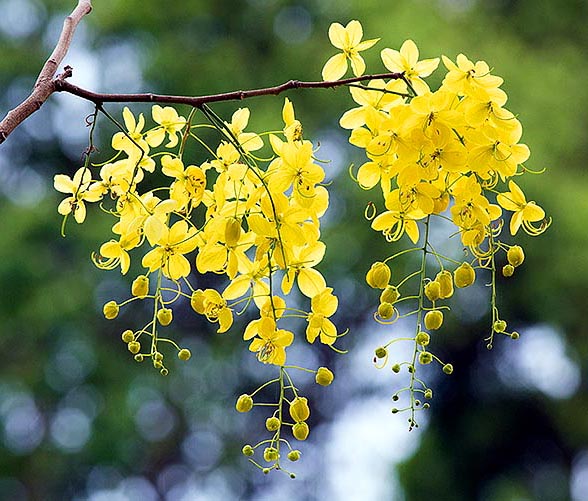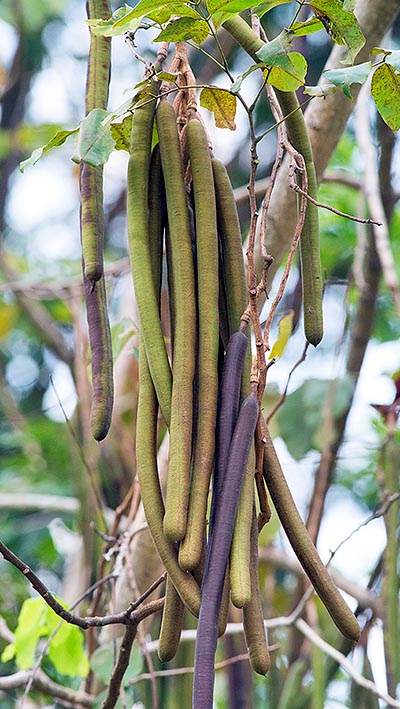Family : Fabaceae

Text © Pietro Puccio

English translation by Mario Beltramini

Cultivated since remote times due to the beauty of the big drooping inflorescences and the medicinal properties, Cassia fistula might be native to deciduous forests of India, Sri Lanka and South-East Asia © Giuseppe Mazza
The generic name comes from the Greek “κασια” (casia) utilized by Dioscorides and coming from the Hebrew name, “quetsi’oth”, of a plant; the specific name is the Latin name “fistula” = tube, with reference to the shape of the fruits.
Common names: golden shower, Indian laburnum, purging cassia, purging fistula (English); sonaru (Assamese); sonali (Bengali); mai lum, ngujat (Burmese); chang kuo tzu shu, la chang shu (Chinese); bâton casse, canéficer, casse doux, douche d’or (French); amaltas, kerla (Hindi); khoun (Lao); kritamalam, konna (Malayalam); dulang, tengguli (Malay); briksha, rajbrikcha (Nepali); cana-fístula, cássia-fístula, cássia-imperial, chuva-de-ouro (Portuguese-Brazil); suvarnaka, ràjataru (Sanskrit); cañafístula, lluvia de oro (Spanish); sarakkonrai (Tamil); reylu, suvarnam, tela (Telugu); ku phe ya, poe so, puu yo, ratchaphruek (Thai); don ga (Tibetan); bo cap nuoc, muong bo-cap (Vietnamese).
The Cassia fistula L. (1753) is a deciduous or semi-deciduous tree, up to 20 m tall, with smooth and greyish bark in the young specimens tending to turn wrinkled and brown with the age.
Spirally arranged leaves paripinnate, 20-45 cm long, with 3-8 pairs of oblong-ovate leaflets with entire margin and obtuse or pointed apex, 6-18 cm long and 4-8 cm broad, of intense green colour and glossy above.

The long legumes, with laxative pulp, have suggested the name of the species, from the Latin fistula, meaning tube © Giuseppe Mazza
The fruit is a hanging indehiscent legume, cylindrical, 30-60 cm long and of about 2 cm of diameter, of blackish brown colour when ripe, containing numerous obovate-ellipsoid seeds, rather flattened, of glossy brown colour, 0,8-1 cm long and 0,6-0,7 cm broad, surrounded by blackish viscous pulp, arranged transversally and separated by a papery septum.
It propagates by seed, perviously scarified and immersed in water for one day, in sandy loam maintained humid at the temperature of 24-26 °C, with germination times of 2-4 weeks and first blooming after 8-10 years in the tropics, the times get longer in the subtropical and temperate-warm zones; it reproduces also by cutting and by air layering.
Species of very high ornamental and landscape value, amply cultivated in the tropical, subtropical and marginally temperate-warm climate countries, where it can bear lowest values of temperature, if exceptional and very short lasting, up to about -3 °C; utilizable in parks and in gardens as isolated specimen or in group and as road tree.
It abundantly blooms in late spring or early summer, depending on the climate, sporadically later, requires full sun and perfectly draining soils, preferably calcareous, moreover, is moderately resistant to drought and salinity.
The young plants may have a disorderly look due to the branches that tend to be drooping, are useful therefore appropriate prunings for a more compact foliage.
The bark, because of the presence of tannins (about 10%), is locally utilized in the leather tanning, and from it they get a red dye; the wood, hard, heavy and long lasting, is utilized in the constructions and for the fabrication of agricultural tools and hand crafted and artistic objects.
All parts of the plant are toxic, particularly the seeds; the cortex of the roots, the leaves, the flowers and the pulp of the fruit are utilized since remote times in the traditional medicine by various populations, in particular the pulp, due to its laxative action, which has contributed in the vast diffusion of the species, and whose presence is permitted within the European Community in the dietary supplements.
The tree and its flowers are the flora symbols of Thailand and the flower of the state of Kerala.
Synonyms: Bactyrilobium fistula (L.) Willd. (1809); Cassia rhombifolia Roxb. (1814); Cassia fistuloides Collad. (1816); Cassia excelsa Kunth (1823); Cassia bonplandiana DC. (1825); Cathartocarpus excelsus G. Don (1832); Cathartocarpus fistuloides (Collad.) G. Don (1832); Cathartocarpus rhombifolius (Roxb.) G. Don (1832).
→ To appreciate the biodiversity within the family of FABACEAE please click here.
